一一.问题描述
问题描述
g2o简介简介
(来源:Course On SLAM)
目标,求
X ∗, L∗ = argmaxP(x0)
M
∏
i=1
P(xi | xi−1, ui)
K
∏
k =1
P(zk | xik
, ljk
)
或者令
求
ek(xik −1, xik
) = fik
(xik −1, uik
) − xik
ek(xik
, ljk
) = hk(xik
, ljk
) − zk
X ∗, L∗ = argmin∑ ek(xi, xj)TΩek(xi, xj) + ∑ ek(xi, lj)TΩek(xi, lj)
g2o框架框架
�
(来源:g2o论文)
解方程
HΔx ∗ = − b
当landmarks >> poses,Schur补:
(
)
�
(
Hpp Hpl
HT
pl Hll
)(
Δx ∗
p
Δx ∗
l
)
(
−bp
−bl
)
=
(
1 −HplH −1
ll
0
1
)
(
Hpp − HplH −1
ll HT
pl
HT
pl
)(
Δx ∗
p
Δx ∗
l
)
0
Hll
(
=
−bp + HplHllbl
bl
)
(Hpp − HplH −1
ll HT
pl)Δx ∗
p = − bp + HplH −1
ll bl
两边分别乘以
得到
第一个方程:
第二个方程
HllΔx ∗
l = − bl − HT
plΔx ∗
p
Jacobian和和Hessian的形式的形式
Jacobian矩阵:
�
Hessian矩阵:
�
代码代码
一个简单的例子:
一个简单的例子:tutorial_slam2d
int numNodes = 300;
Simulator simulator;
simulator.simulate(numNodes, sensorOffsetTransf);
/*********************************************************************************
* creating the optimization problem
********************************************************************************/
// dimension of the pose and landmark vertices (-1 if variable)
typedef BlockSolver< BlockSolverTraits<-1, -1> > SlamBlockSolver;
typedef LinearSolverCSparse SlamLinearSolver;
// allocating the optimizer
SparseOptimizer optimizer;
SlamLinearSolver* linearSolver = new SlamLinearSolver();
linearSolver->setBlockOrdering(false);
SlamBlockSolver* blockSolver = new SlamBlockSolver(linearSolver);
OptimizationAlgorithmLevenberg* solver = new OptimizationAlgorithmLevenberg(blockSolve
r);
�
optimizer.setAlgorithm(solver);
// add the parameter representing the sensor offset
ParameterSE2Offset* sensorOffset = new ParameterSE2Offset;
sensorOffset->setOffset(sensorOffsetTransf);
sensorOffset->setId(0);
optimizer.addParameter(sensorOffset);
// adding the odometry to the optimizer
// first adding all the vertices
cerr << "Optimization: Adding robot poses ... ";
for (size_t i = 0; i < simulator.poses().size(); ++i)
{
const Simulator::GridPose& p = simulator.poses()[i];
const SE2& t = p.simulatorPose;
VertexSE2* robot = new VertexSE2;
robot->setId(p.id);
robot->setEstimate(t);
optimizer.addVertex(robot);
}
cerr << "done." << endl;
// second add the odometry constraints
cerr << "Optimization: Adding odometry measurements ... ";
for (size_t i = 0; i < simulator.odometry().size(); ++i)
{
const Simulator::GridEdge& simEdge = simulator.odometry()[i];
EdgeSE2* odometry = new EdgeSE2;
odometry->vertices()[0] = optimizer.vertex(simEdge.from);
odometry->vertices()[1] = optimizer.vertex(simEdge.to);
odometry->setMeasurement(simEdge.simulatorTransf);
odometry->setInformation(simEdge.information);
optimizer.addEdge(odometry); // second add the odometry constraints
}
cerr << "done." << endl;
// add the landmark observations
cerr << "Optimization: add landmark vertices ... ";
for (size_t i = 0; i < simulator.landmarks().size(); ++i)
{
const Simulator::Landmark& l = simulator.landmarks()[i];
VertexPointXY* landmark = new VertexPointXY;
landmark->setId(l.id);
landmark->setEstimate(l.simulatedPose);
�
landmark->setMarginalized(true); //Schur!!!!!
optimizer.addVertex(landmark);
}
cerr << "done." << endl;
cerr << "Optimization: add landmark observations ... ";
for (size_t i = 0; i < simulator.landmarkObservations().size(); ++i)
{
const Simulator::LandmarkEdge& simEdge = simulator.landmarkObservations()[i];
EdgeSE2PointXY* landmarkObservation = new EdgeSE2PointXY;
landmarkObservation->vertices()[0] = optimizer.vertex(simEdge.from);
landmarkObservation->vertices()[1] = optimizer.vertex(simEdge.to);
landmarkObservation->setMeasurement(simEdge.simulatorMeas);
landmarkObservation->setInformation(simEdge.information);
landmarkObservation->setParameterId(0, sensorOffset->id());
optimizer.addEdge(landmarkObservation); // add landmark observations
}
cerr << "done." << endl;
/*********************************************************************************
* optimization
********************************************************************************/
// dump initial state to the disk
optimizer.save("tutorial_before.g2o");
// prepare and run the optimization
// fix the first robot pose to account for gauge freedom
VertexSE2* firstRobotPose = dynamic_cast(optimizer.vertex(0));
firstRobotPose->setFixed(true);
// prepare and run the optimization
optimizer.setVerbose(true);
cerr << "Optimizing" << endl;
optimizer.initializeOptimization();
optimizer.optimize(10);
cerr << "done." << endl;
optimizer.save("tutorial_after.g2o");
// freeing the graph memory
optimizer.clear();
// destroy all the singletons
�
Factory::destroy();
OptimizationAlgorithmFactory::destroy();
HyperGraphActionLibrary::destroy();
注: firstRobotPose->setFixed(true);
Local Accuracy and Global Consistency for Efficient Visual SLAM
If one proceeds exactly as explained above, one would realise that
the matrix JTΛzJ is singular. This is caused by our decision to
optimise over all poses T1, . . . , Tm and all points y1, . . . , yn. To get a
better understanding of this, let us first consider bundle adjustment
using a calibrated stereo rig; i.e. the observations z are three
dimensional and the prediction function is zˆstereo. Now, let us
assume that ¯T1, . . . , ¯Tm, ¯y1, . . . , ¯yn is the optimal solution to the BA
minimization problem where the reprojection error of each point in
each frame is minimal. It is important to note that all point
measurements are relative, so that the solution does not depend on
the absolute frame of reference. If we were now to apply a general
rigid body transformation A ∈ SE(3) to all parameters, the
reprojection error would still be minimal. In other words, A ¯T1, . . . , ¯Tm,
A¯y1, . . . , A¯yn is another optimal solution to the problem. Therefore,
we do have a six dimensional solution space, and thus we say that
there is a gauge freedom of six dimensions. That is the reason why
the approximated Hessian is rank deficient. We can remove the
gauge freedom by fixing six parameters, e.g. the first pose. Thus, we
would optimize over the poses T2, . . . , Tm and all points y1, . . . , yn
while keeping T1 fixed which now defines the reference frame.
四件事:
1. 设置优化算法OptimizationAlgorithmLevenberg和线性求解
器LinearSolverCSparse
2. 设置vertices(poses and landmarks) 和 edges (odometry constraints and
landmark observations)
3. optimizer.initializeOptimization();
4. optimizer.optimize(10);
部分关键数据和函数
部分关键数据和函数
�
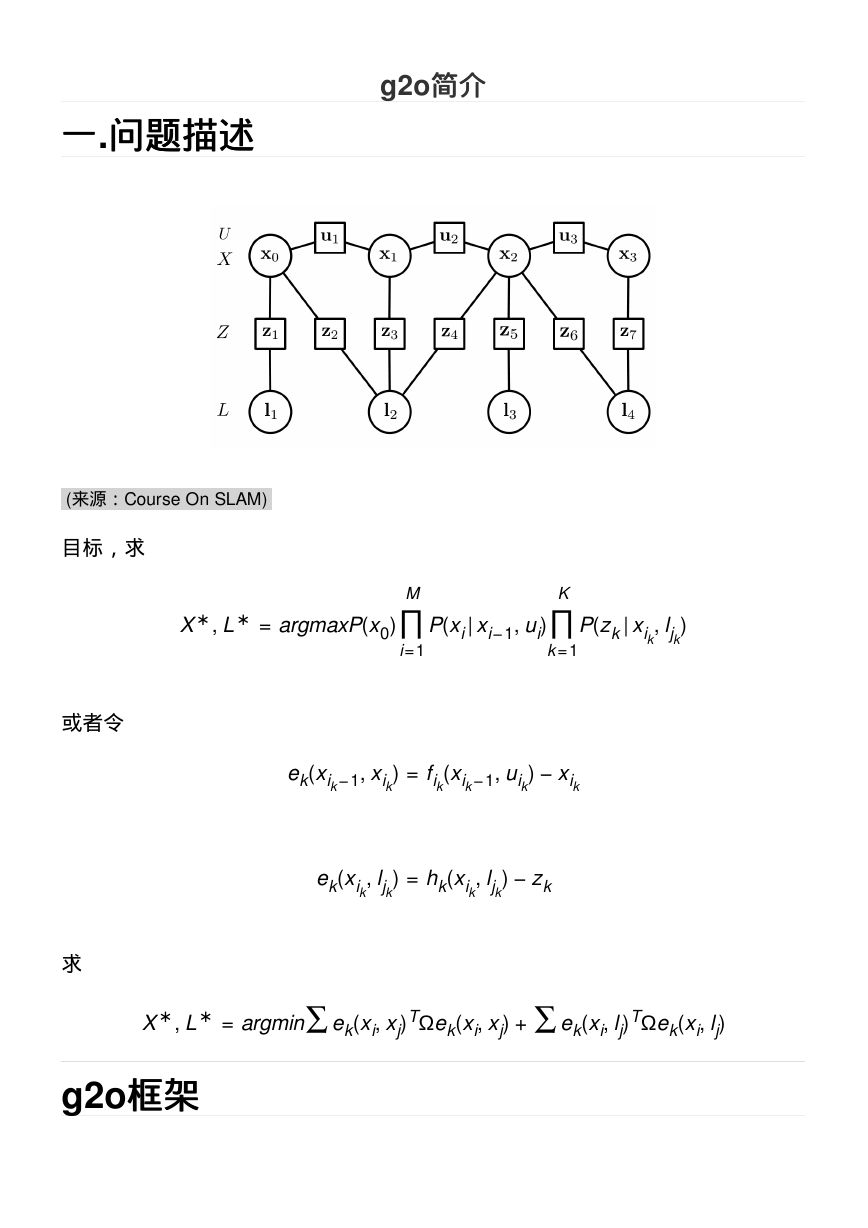
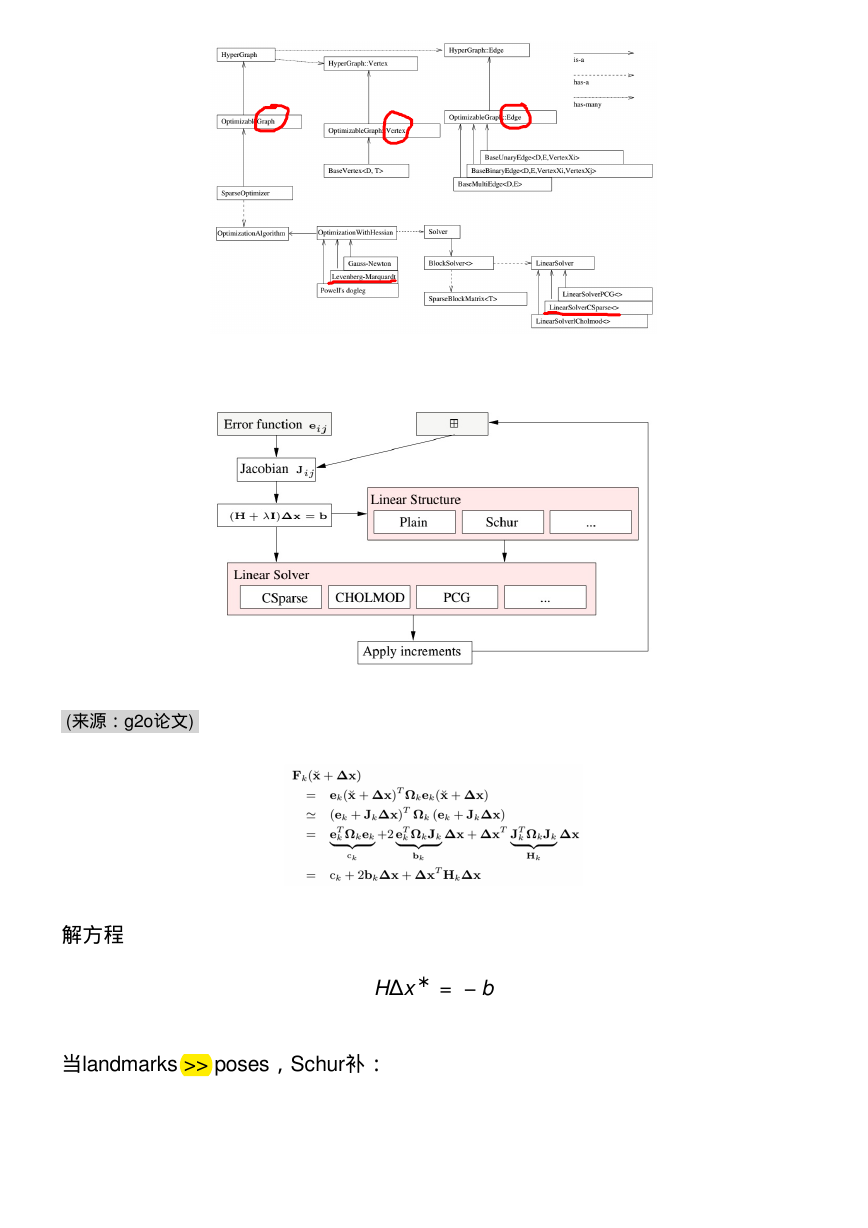
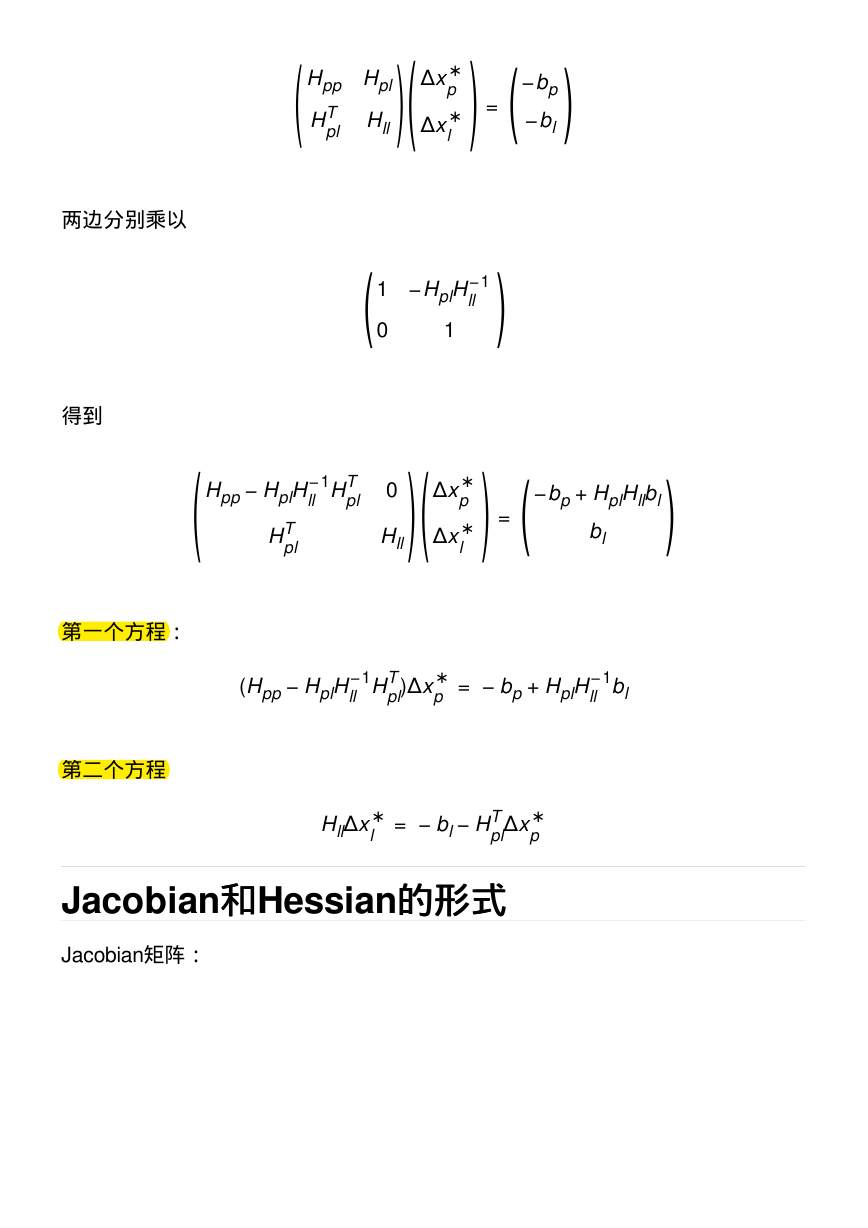
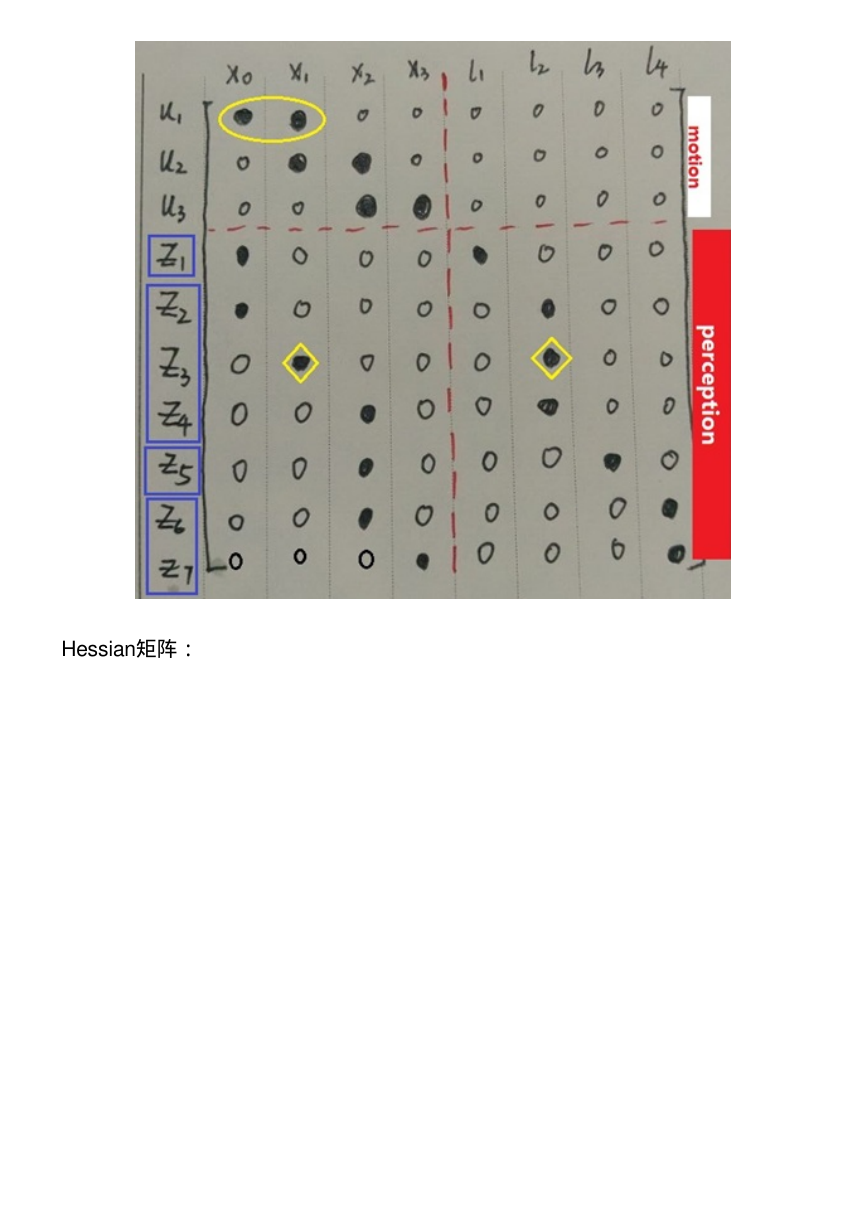
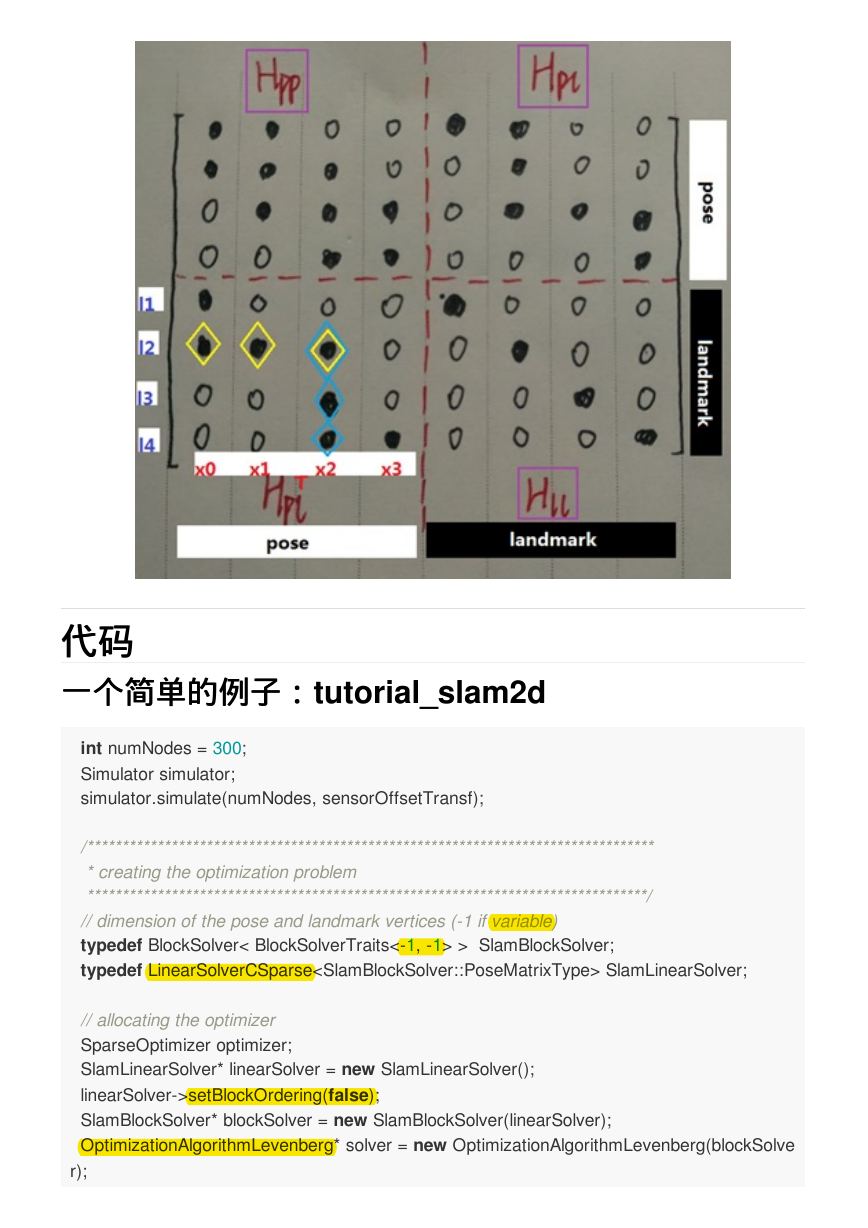
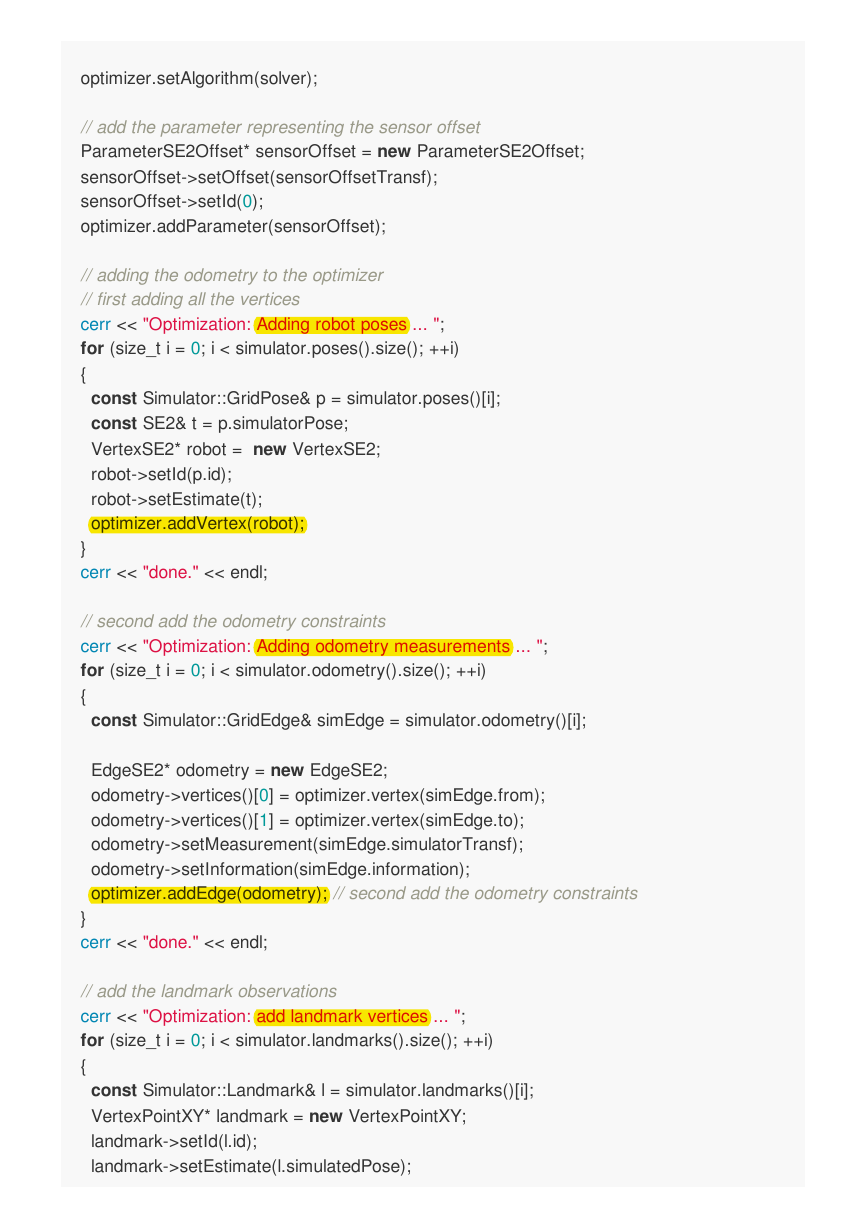
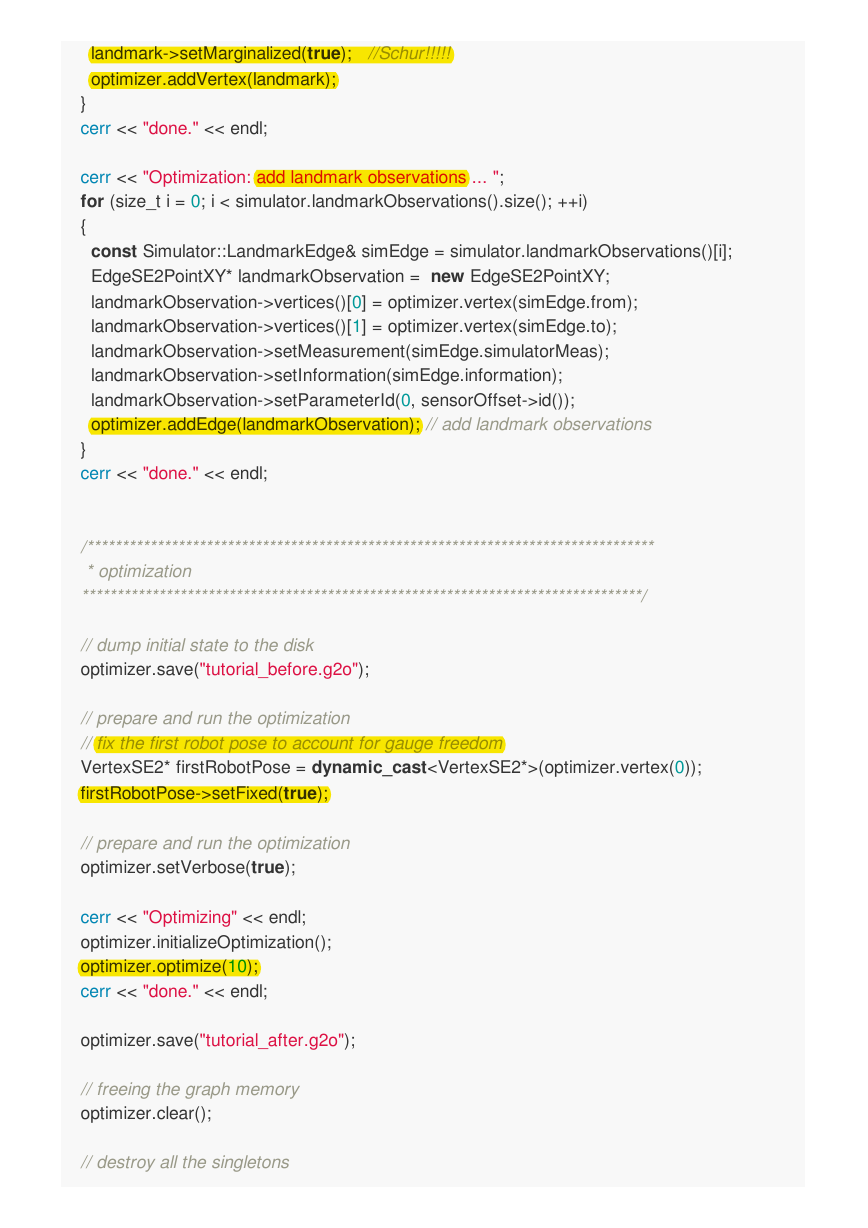
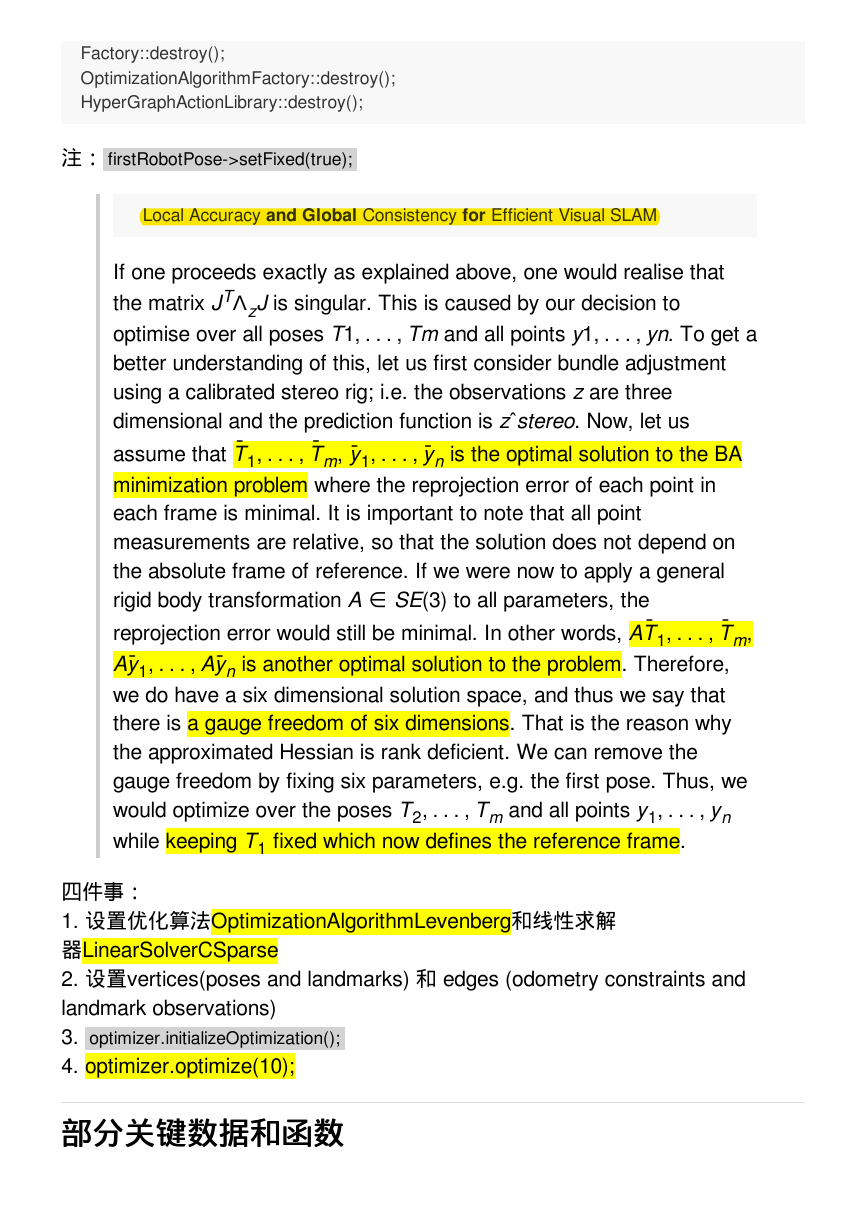








 2023年江西萍乡中考道德与法治真题及答案.doc
2023年江西萍乡中考道德与法治真题及答案.doc 2012年重庆南川中考生物真题及答案.doc
2012年重庆南川中考生物真题及答案.doc 2013年江西师范大学地理学综合及文艺理论基础考研真题.doc
2013年江西师范大学地理学综合及文艺理论基础考研真题.doc 2020年四川甘孜小升初语文真题及答案I卷.doc
2020年四川甘孜小升初语文真题及答案I卷.doc 2020年注册岩土工程师专业基础考试真题及答案.doc
2020年注册岩土工程师专业基础考试真题及答案.doc 2023-2024学年福建省厦门市九年级上学期数学月考试题及答案.doc
2023-2024学年福建省厦门市九年级上学期数学月考试题及答案.doc 2021-2022学年辽宁省沈阳市大东区九年级上学期语文期末试题及答案.doc
2021-2022学年辽宁省沈阳市大东区九年级上学期语文期末试题及答案.doc 2022-2023学年北京东城区初三第一学期物理期末试卷及答案.doc
2022-2023学年北京东城区初三第一学期物理期末试卷及答案.doc 2018上半年江西教师资格初中地理学科知识与教学能力真题及答案.doc
2018上半年江西教师资格初中地理学科知识与教学能力真题及答案.doc 2012年河北国家公务员申论考试真题及答案-省级.doc
2012年河北国家公务员申论考试真题及答案-省级.doc 2020-2021学年江苏省扬州市江都区邵樊片九年级上学期数学第一次质量检测试题及答案.doc
2020-2021学年江苏省扬州市江都区邵樊片九年级上学期数学第一次质量检测试题及答案.doc 2022下半年黑龙江教师资格证中学综合素质真题及答案.doc
2022下半年黑龙江教师资格证中学综合素质真题及答案.doc